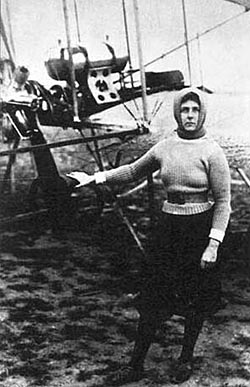|
You Fly, Girl
|
Hilda HewlettFebruary 17, 1864Louisa Herbert, wife of the wealthy Reverend George W. Herbert, gives birth to a daughter they name Hilda Beatrice. She is the second child born in a family which will eventually number six daughters and one son.
1906 There is one female driver in the Trial, a Miss Hind, driving a Singer Tricar, and Hilda acts as her passenger/mechanic. At this point in time, Hilda has two children. Hewlett has become a successful romantic novelist, and soon buys a home in the country .
1909 The two become fast friends, and in October, will go to an aviation meeting, where Hilda will be inspired by the flight of Hubert Latham in an Antoinette monoplane. Blondeau also decides to devote himself to aviation, rather than other forms of engineering. Within a few months, Hilda saves up enough money to purchase a Farman airplane, and she accompanies Blondeau to Camp de Chalons in France to learn how to fly and repair it. Hilda uses the pseudonym Mrs. Grace Bird at this point. Hilda, fluent in French, works alongside the men in the shops while building their new airplane. Photos exist of her clad in long-sleeved blouses and skirts that extend down to the ankle while working on the plane - this is 1909, after all. Blondeau takes the test and receives his license from the Aero Club in France on June 10, 1910. In July, Blondeau and Hilda return to England with the plane, named The Blue Bird. They set up a school called the Hewlett-Blondeau Flying School, at Brooklands (a motor-racing circuit), England. Thomas Octave Murdoch Sopwith will have his first pilot's lesson here (and the rest there is history!). The school is a success, the first in England to "graduate a full-fledged pilot and the first to graduate an army-officer pilot."
August 18, 1911 According to Lebow in her book Before Amelia, female pilots in France "were treated with respect as members of the flying community. In England there was mistrust and even open hostility."
October, 1911 Hilda and Blondeau also begin building airplanes (in particular the Hanriot, which they license to do so from its inventor), which sell. They relocate to a larger place of business, in Battersea, and form Omnia Works. Initially, the pair have trouble from the British labor unions, who wish all employees, regardless of their skill level or jobs, to be paid the same, and of course they can't be fired regardless of how incompetent they are. However, this problem is eventually sorted out. In 1912 the company is awarded a contract to build BE2cs - small biplanes designed by the Royal Aircraft Factory for reconnaissance work. Hilda and co. will relocate to a larger factory in the Leagrace countryside. During the 1914-1918 war, the company trains women to build the planes.
October 27, 1920 Seven years later, "the property was sold to Electrolux, and for the first time, Hilda and Blondeau benefitted from their investment and years of hard work. By this time, Hilda's husband had died. Hilda's son - whom she had taught to fly herself, had fought during the war. Her daughter, in 1927, moves with her family to New Zealand, and Hilda accompanies her. (Hilda had visited New Zealand in 1919 and liked it.)
1929.... or 1930 Hilda journeys between England and New Zealand several times. In 1932, she becomes the first woman passenger to make a "through flight" from London to New Zealand via Jakarta, Indonesia (called Batavia at the time). The trip took eleven days, in a Fokker FVIIb/3m, a KLM airliner.
1930s As the years of her retirement went by, Hilda "was an enthusiastic gardener, loved camping, fly fishing and deep-sea fishing." She became almost blind with glaucoma, but coped well.
August 21, 1943
Bibliography and Webography |
All text © 2006 - 2008 Volcano Seven unless otherwise credited.
All illustrations retain original copyright.
Please contact us with any concerns as to correct attribution.
Any questions, comments or concerns contact Volcano Seven.
